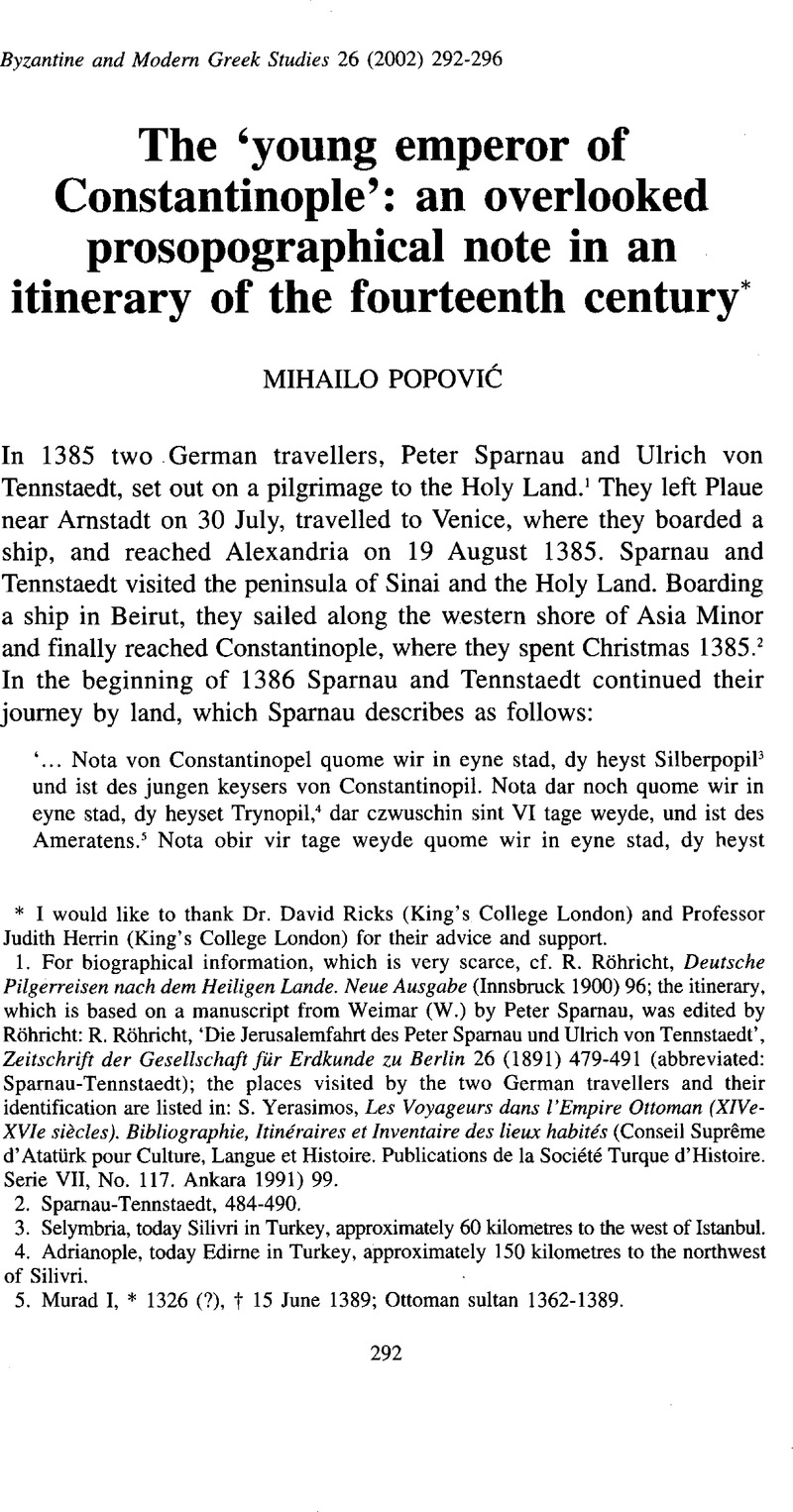No CrossRef data available.
Published online by Cambridge University Press: 22 January 2016

I would like to thank Dr. David Ricks (King’s College London) and Professor Judith Herrin (King’s College London) for their advice and support.
1. For biographical information, which is very scarce, cf.Röhricht, R., Deutsche Pilgerreisen nach dem Heiligen Lande. Neue Ausgabe (Innsbruck 1900) 96 Google Scholar; the itinerary, which is based on a manuscript from Weimar (W.) by Peter Sparnau, was edited by Röhricht: Röhricht, R., ‘Die Jerusalemfahrt des Peter Sparnau und Ulrich von Tennstaedt’, Zeitschrift der Gesellschaft für Erdkunde zu Berlin 26 (1891) 479–491 Google Scholar (abbreviated: Sparnau-Tennstaedt); the places visited by the two German travellers and their identification are listed in: Yerasimos, S., Les Voyageurs dans l’Empire Ottoman (XlVe-XVIe siècles). Bibliographie, Itinéraires et Inventaire des lieux habités (Conseil Suprême d’Atatiirk pour Culture, Langue et Histoire. Publications de la Société Turque d’Histoire. Serie VII, No. 117. Ankara 1991) 99 Google Scholar.
2. Sparnau-Tennstaedt, 484-490.
3. Selymbria, today Silivri in Turkey, approximately 60 kilometres to the west of Istanbul.
4. Adrianople, today Edirne in Turkey, approximately 150 kilometres to the northwest of Silivri.
5. Murad I, * 1326 (?), † 15 June 1389; Ottoman sultan 1362-1389.
6. Philippopolis, today Plovdiv in Bulgaria, approximately 160 kilometres to the northwest of Edirne.
7. Tûmovo, today Veliko Târnovo in Bulgaria, approximately 130 kilometres to the northeast of Plovdiv.
8. Sparnau-Tennstaedt, 490; ‘... From Constantinople we came to a city, which is called Selymbria and belongs to the young emperor of Constantinople. Then we came to a city, which is called Adrianople, lies six days away [from Selymbria], and belongs to Murad I. After four days we came to a city, which is called Philippopolis and belongs to Murad I. From Philippopolis we came to the empire of Bulgaria and to a city called Tûrnovo, ...’ (my translation).
9. The Oxford Dictionary of Byzantium 2, ed. Kazhdan, A.P. et al. (New York-Oxford 1991)Google Scholar John V Palaiologos, 1050 (abbreviated: ODB); Prosopographisches Lexikon der Palaiologenzeit, 9. Faszikel: [#Όγουζάλπης] - Πέτκος, ed. Trapp, E., Beyer, H.-V., Kaplaneres, S. (Österreichische Akademie der Wissenschaften, Veröffentlichungen der Kommission für Byzantinistik, Band 1/9, ed. Hunger, H.. Wien 1989) 95-96Google Scholar, No. 21485 (abbreviated: PLP).
10. For literature published until 1989 on the family of the Palaiologoi in the fourteenth century cf. volume 1/9 of the PLP, for literature published since then cf.: Dabrowska, M., Lacinniczki nad Bosforem. Malzenstwa bizantynsko-lacinskie w cesarskiej rodzinie Paleologów (XIII-XV w.) [The Latin ladies on the Bosporus: Byzantine-Latin marriages in the imperial family of the Palaiologoi (13th-15th centuries)] (Lodz 1996)Google Scholar; Ganchou, T., ‘Autour de Jean VII: luttes dynastiques, interventions étrangères et résistance orthodoxe à Byzance (1373-1409)’, in: Coloniser au moyen âge, ed. Balard, M., Ducellier, A. (Paris 1995) 367–385 Google Scholar; Geschichte und Kultur der Palaiologenzeit, Referate des internationalen Symposions zu Ehren von Herbert Hunger (Wien, 30. November bis 3. Dezember 1994), ed. Seibt, W. (Österreichische Akademie der Wissenschaften, Veröffentlichungen der Kommission für Byzantinistik, Denkschriften, Phil.-hist. Klasse 241. Wien 1996)Google Scholar; Katsone, P., ‘#O γάμος тои αυτοκράτορα Ιωάννη Z’ Παλοαολόνου με την Ευγενία Gattiluzi (1396/97)’, Byzantiaka 11 (1991) 181–201 Google Scholar; Katsone, P., ‘H δεΰτερη στέψη του αυτοκράτορα Μανουηλ B’ Παλαιολόνου’, in: IB’ Πανελλήνιο Ιστορικό Συνέδριο (Maioc 1991), Πρακτικά (Thessaloniki 1992) 139–150 Google Scholar; Katsone, P., ‘Δυο ταξίδια του αυτοκράτορα Ιωάννη Z’ Παλαιολόγου (1390-1408) στη Δΰση (1389-1392)’, in IT’ Πανελλήνιο Ιστορικό Συνέδριο (29-31 Μαίου 1992), Πρακτικά (Thessaloniki 1993) 213–229 Google Scholar; Radić, R., Vreme Jovana V Paleologa (1332-1391) [The time of John V Palaiologos] (Belgrade 1993)Google Scholar.
11. ODB 1, Andronikos IV Palaiologos, 95-96; PLP, 1/9, 84, No. 21438.
12. ODB 2, Manuel II Palaiologos, 1291-1292; PLP, 1/9, 101-102, No. 21513.
13. PLP, 1/9, 103, No. 21522.
14. ODB 3, Theodore I Palaiologos, 2040; PLP, 1/9, 88-89, No. 21460.
15. For the history of Selymbria in classical antiquity cf.Oberhummer, E., RE 2.R. 2 (1923) 1324–1327 Google Scholar.
16. Oberhummer, E., RE 2.R. 2 (1923) 1327 Google Scholar; Velkov, V., ‘Au sujet du Codex Theodosianus XV 1,42’, BS 21 (1960) 274–281 Google Scholar.
17. ODB 3, Selymbria, 1867; also cf.Dirimtekin, F., ‘La forteresse byzantine de Selymbria’, in: Actes du Xe Congrès international des études byzantines 1955 (Istanbul 1957) 127–129 Google Scholar.
18. Magdalino, P., ‘Byzantine churches of Selymbria’, DOP 32 (1978) 313 Google Scholar; OBD 3, Selymbria, 1867.
19. Maksimović, Lj., The Byzantine provincial administration under the Palaiologoi (Amsterdam 1988) 51fGoogle Scholar.
20. On the life of Alexios Apokaukos cf. PLP I/1, 109-110, No. 1180 and ODB 1, Apokaukos, Alexios, 134-135; on the churches in Selymbria cf.Eyice, S., ‘Alexis Apocauque et l’église byzantine de Sélymbria (Silivri)’, B 34 (1964) 77-104Google Scholar; Eyice, S., ‘Encore une fois l’église d’Alexis Apocauque à Selymbria (Silivri)’, В 48 (1978) 406–416 Google Scholar; Feld, O., ‘Noch einmal Alexios Apokaukos und die byzantinische Kirche von Selymbria (Silivri)’, B 37 (1967) 57-65Google Scholar; Magdalino, P., ‘Byzantine churches of Selymbria’, DOP 32 (1978) 309–318 Google Scholar; Eyice identifies the Fatih Camii in the centre of the medieval citadel with Apokaukos’ foundation, while Magdalino (313f.) locates his church by the shore outside the walls, but does not exclude the possibility that Apokaukos made two major foundations in the city.
21. Mešanović, S., Jovan VII Paleolog [John VII Palaiologos] (Belgrade 1996) 53 Google Scholar, 140; Nicol, D.M., The Last Centuries of Byzantium 1261-1453 (London 1972) 209 Google Scholar, 292-293, 296, 302-303; PLP, 1/9, 84, No. 21438, 93, No. 21480.
22. Dölger, F., ‘Johannes VII., Kaiser der Rhomäer 1390-1408’, BZ 31 (1931) 21 Google Scholar, 26; Mešanović, op.cit. 29, 42, 138, 140; Nicol, op.cit. 290, 294; ODB 2, John VII Palaiologos, 1052; PLP, 1/9, 92-93, No. 21480.